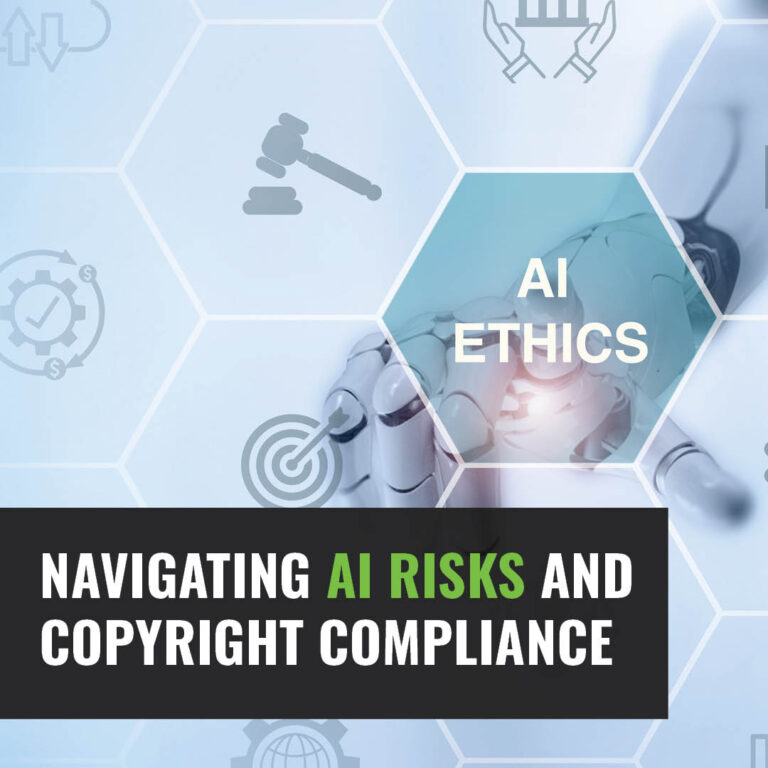Navigating AI Risks and Copyright Compliance

AI offers incredible opportunities, but it also presents risks, particularly around legal and ethical concerns. Addressing these risks head-on is key to successfully using AI.
Key Risks in AI
- Copyright Issues: Nonhuman outputs are not currently copyrightable unless significant human input is involved. This means that businesses must carefully consider how they use AI for content creation. Relying solely on generative AI without human oversight can lead to legal issues, especially when it comes to intellectual property.
- Bias in AI: AI models are only as good as the data they are trained on. If the training data is biased, the AI’s outputs will reflect those biases. This can be particularly harmful in areas like hiring, lending, or advertising, where biased AI could lead to discriminatory practices.
- AI Hallucinations: Sometimes, AI can generate incorrect or misleading information—known as “hallucinations.” This poses a significant reputational risk, especially when businesses rely on AI for customer interactions or content creation.
- Inaction with Using AI: Not adopting AI might be the biggest risk of all. Businesses that hesitate to integrate AI into their operations will fall behind competitors who leverage AI for efficiency, innovation and more.
How to Mitigate AI Risks
- Zero-Risk Approach: To minimize legal risks, ensure that all AI training data is properly licensed. AI should primarily be used for tasks like editing and automation, while the core creative work—such as original content, design and inventions—should remain human-driven. This approach helps maintain control over creative outputs and avoids potential copyright or intellectual property issues.
- Selecting the Right AI Tools: Carefully evaluate AI tools before adoption. Look at the long-term roadmap of the tool and take a strategic view of its future development. Ensure the provider will indemnify you in case of legal issues and review what data the tool has access to, ensuring that all data is properly licensed. Working with an agency or trusted partner can help you identify the right tools for your specific needs, leveraging their expertise in AI solutions. Additionally, consider choosing tools from well-established companies (e.g., Microsoft, Google) that are likely to be reliable and continue supporting their AI systems over time.
- Avoid Using AI for Sensitive Data and Projects: When integrating AI into your business, avoid using it for sensitive data or high-risk projects, especially if the AI tool’s data handling practices are unclear. Ensure that AI is applied to areas where data privacy and security can be closely monitored and consider keeping sensitive tasks human-driven to reduce the risk of data breaches or misuse.
- Striking the Right Balance Between Personalization and Privacy: AI allows for highly personalized experiences, but it’s important to ensure that this personalization feels helpful rather than intrusive. Companies like Netflix and Spotify provide great examples of balancing customization with respect for user privacy, delivering tailored recommendations in a way that delights users without feeling “creepy.” Businesses should aim to enhance customer experiences with AI-driven personalization while remaining mindful of how much data is being used and shared.
- Transparency and Trust: More consumers are frightened by AI than excited by it, so it’s crucial to be clear about how AI is being used, especially in customer-facing applications. Transparency builds trust, alleviating concerns about AI misuse and encouraging better data sharing. Just as visible protections, like a fence along a mountain edge, make people more comfortable exploring new heights, clear AI policies and protections make customers more willing to engage with AI-powered services and share their data. Many companies, such as Apple and Microsoft, are leading the way by prioritizing trust and privacy, while still using AI heavily, showing that responsible AI use and transparency can coexist with success.
- Balancing Safety and Risk: Businesses must balance innovation with safety, ensuring that AI is used responsibly without stifling its potential. Establishing strong policies early on is key—better brakes (having well-thought-out policies in place before issues arise) allow for faster speeds in AI adoption and innovation. When businesses know they have safeguards, they can explore AI’s capabilities with greater confidence and agility.
Explore More AI Topics
Ready to explore how AI can enhance your business? Review more of our articles on AI or contact us to discuss the opportunities AI can bring to your marketing and operations.

